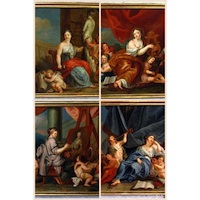 Journal18 est une revue numérique à comité de lecture, en libre accès, consacrée à l’examen de l’art et de la culture du XVIIIe siècle dans le monde entier. Inspiré par la richesse du champ de l’histoire de l’art du XVIIIe siècle, Journal18 a été créé pour représenter et promouvoir cette richesse.
Journal18 est une revue numérique à comité de lecture, en libre accès, consacrée à l’examen de l’art et de la culture du XVIIIe siècle dans le monde entier. Inspiré par la richesse du champ de l’histoire de l’art du XVIIIe siècle, Journal18 a été créé pour représenter et promouvoir cette richesse.
Journal18 est la première revue consacrée au domaine de l’histoire de l’art du XVIIIe siècle, l’une des rares publication d’accès en ligne, entièrement ouvert à la discipline de l’histoire de l’art.
Deux fois par an, Journal18 publiera des numéros thématiques contenant des articles qui examinent tous les aspects de la culture visuelle et matérielle du dix-huitième siècle. En outre, Journal18 offrira également un forum pour l’échange intellectuel dans une section distincte « Notes & Requêtes »: un espace pour des notes concises, des critiques, des découvertes d’archives, ou des réflexions savantes.
Fondé et dirigé par les historiens d’art du XVIIIe siècle basé à Los Angeles, New York et Oxford, Journal18 est conseillé et soutenu par un comité de rédaction international composé d’universitaires et de conservateurs de musée (voir ci-dessous). Le journal est affilié à HECAA, l’association professionnelle des historiens de l’art et de l’architecture du dix-huitième siècle et avec l’Institut des Beaux-Arts de New York.
Journal18 va lancer son premier numéro au printemps 2016.
Issue #1 Multilayered (Spring 2016)
Art history’s material turn, informed by anthropology, material culture, and consumption studies, has prompted new interest in both the physicality and the social lives of artworks. Examining the ways that eighteenth-century art objects were produced, transported, and transformed helps us to understand how they were perceived and reimagined in different cultural and temporal contexts. In the workshops and collective spaces of artistic design and manufacture, objects became the creative products of many minds and many hands, simultaneously and successively.Likewise in their afterlives as commodities and possessions, objects were continually altered through use and re-use, each transaction constituting a reframing – sometimes literal – as objects inhabited new settings or were subjected to damage, aging, or rejuvenation.
This inaugural issue of Journal18 explores the multilayered nature of eighteenth-century art. Our focus will be on artworks that bear traces of multiple hands as a result of workshop production, cross-cultural exchange, re-use, restoration, vandalism, or other factors. Among the questions we aim to consider:
who were the many people involved in art’s production and reproduction (artists, collectors, scholars, dealers, handlers, and restorers)? How were eighteenth-century artworks made, repurposed, transported, and conserved? How were they translated across media as well as across time, space, and culture? And what is the creative effect of non-creative acts like accidents or defacement?
By taking a ‘multilayered’ approach, we wish not only to reexamine traditional art historical categories – such as style, originality, or authorship – but also to encourage new methodological perspectives and to find new meaning in the materiality of art objects.
Contact : editor@journal18.org
Founding Editors
Noémie Etienne (Getty Research Institute)
Meredith Martin (Institute of Fine Arts – NYU)
Hannah Williams (University of Oxford)
Editorial Board
Nebahat Avcioglu (Hunter College/CUNY)
Finbarr Barry Flood (Institute of Fine Arts, New York)
Esther Bell (Fine Arts Museums of San Francisco)
Daniela Bleichmar (University of Southern California)
Jeffrey Collins (Bard Graduate Center, New York)
Thomas Crow (Institute of Fine Arts, New York)
Craig Hanson (Calvin College)
Anne Higonnet (Barnard College/Columbia University)
Kristina Kleutghen (Washington University, St Louis)
Anne Lafont (INHA, Paris)
Ewa Lajer-Burcharth (Harvard University)
Mark Ledbury (University of Sydney)
Katie Scott (Courtauld Institute of Art)
Charlotte Vignon (Frick Collection)
Michael Yonan (University of Missouri)
Plus d’informations : http://www.journal18.org
Page Facebook

Leave a Reply
You must be logged in to post a comment.